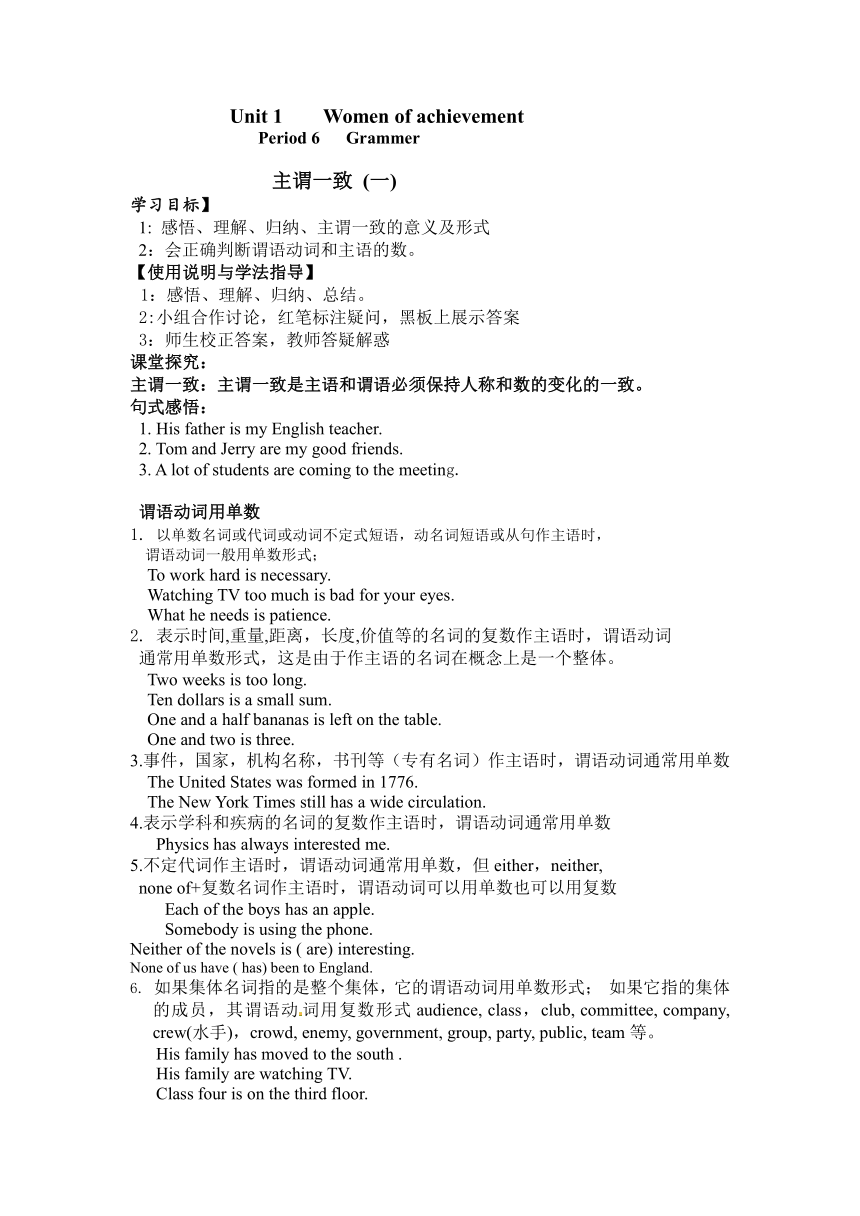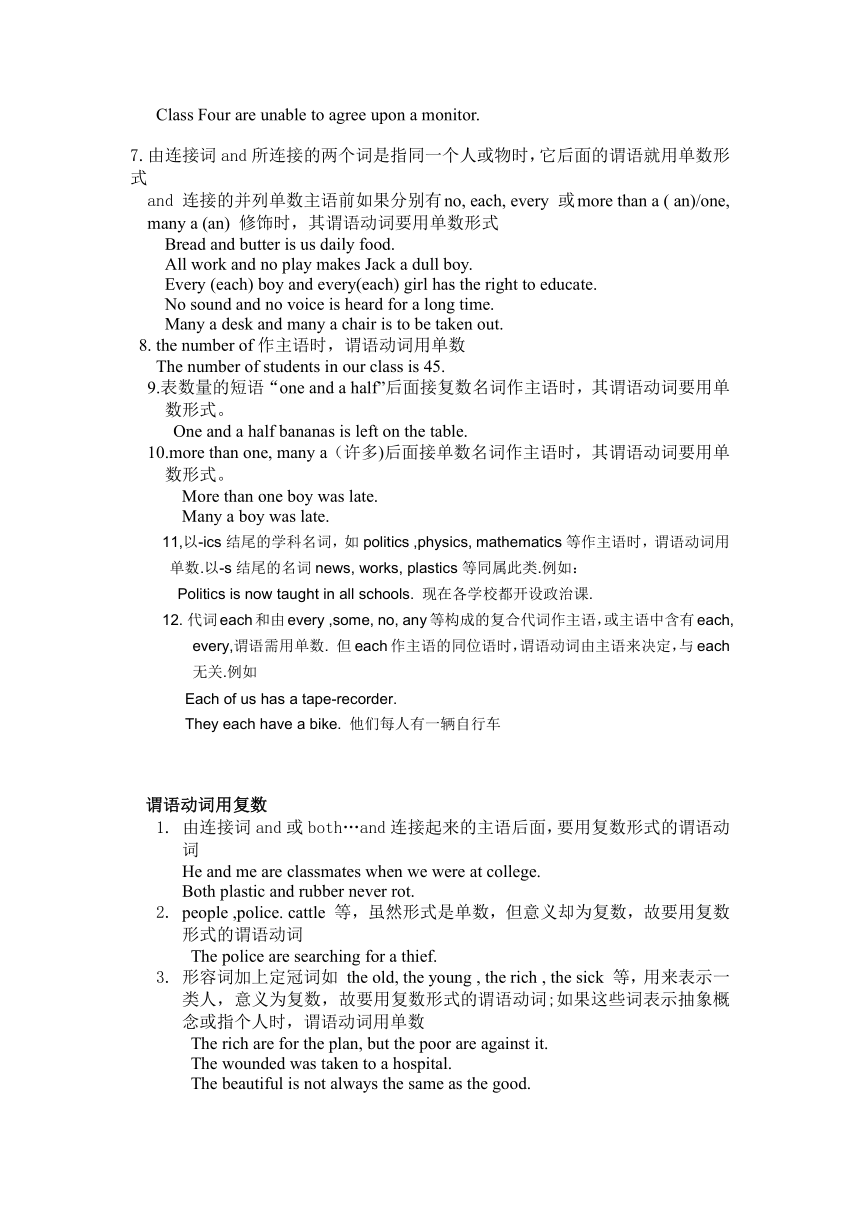人教版(新课程标准)必修四:Unit 1 Women of achievement Grammar学案
文档属性
| 名称 | 人教版(新课程标准)必修四:Unit 1 Women of achievement Grammar学案 |  | |
| 格式 | doc | ||
| 文件大小 | 53.0KB | ||
| 资源类型 | 教案 | ||
| 版本资源 | 人教版(新课程标准) | ||
| 科目 | 英语 | ||
| 更新时间 | 2021-12-25 20:28:18 | ||
图片预览


文档简介
Unit 1 Women of achievement
Period 6 Grammer
主谓一致 (一)
学习目标】
1: 感悟、理解、归纳、主谓一致的意义及形式
2:会正确判断谓语动词和主语的数。
【使用说明与学法指导】
1:感悟、理解、归纳、总结。
2:小组合作讨论,红笔标注疑问,黑板上展示答案
3:师生校正答案,教师答疑解惑
课堂探究:
主谓一致:主谓一致是主语和谓语必须保持人称和数的变化的一致。
句式感悟:
1. His father is my English teacher.
2. Tom and Jerry are my good friends.
3. A lot of students are coming to the meeting.
谓语动词用单数
以单数名词或代词或动词不定式短语,动名词短语或从句作主语时,
谓语动词一般用单数形式;
To work hard is necessary.
Watching TV too much is bad for your eyes.
What he needs is patience.
表示时间,重量,距离,长度,价值等的名词的复数作主语时,谓语动词
通常用单数形式,这是由于作主语的名词在概念上是一个整体。
Two weeks is too long.
Ten dollars is a small sum.
One and a half bananas is left on the table.
One and two is three.
3.事件,国家,机构名称,书刊等(专有名词)作主语时,谓语动词通常用单数
The United States was formed in 1776.
The New York Times still has a wide circulation.
4.表示学科和疾病的名词的复数作主语时,谓语动词通常用单数
Physics has always interested me.
5.不定代词作主语时,谓语动词通常用单数,但either,neither,
none of+复数名词作主语时,谓语动词可以用单数也可以用复数
Each of the boys has an apple.
Somebody is using the phone.
Neither of the novels is ( are) interesting.
None of us have ( has) been to England.
6. 如果集体名词指的是整个集体,它的谓语动词用单数形式; 如果它指的集体的成员,其谓语动词用复数形式audience, class,club, committee, company, crew(水手),crowd, enemy, government, group, party, public, team等。
His family has moved to the south .
His family are watching TV.
Class four is on the third floor.
Class Four are unable to agree upon a monitor.
7.由连接词and所连接的两个词是指同一个人或物时,它后面的谓语就用单数形式
and 连接的并列单数主语前如果分别有no, each, every 或more than a ( an)/one, many a (an) 修饰时,其谓语动词要用单数形式
Bread and butter is us daily food.
All work and no play makes Jack a dull boy.
Every (each) boy and every(each) girl has the right to educate.
No sound and no voice is heard for a long time.
Many a desk and many a chair is to be taken out.
8. the number of作主语时,谓语动词用单数
The number of students in our class is 45.
9.表数量的短语“one and a half”后面接复数名词作主语时,其谓语动词要用单数形式。
One and a half bananas is left on the table.
10.more than one, many a(许多)后面接单数名词作主语时,其谓语动词要用单数形式。
More than one boy was late.
Many a boy was late.
11,以-ics结尾的学科名词,如politics ,physics, mathematics等作主语时,谓语动词用单数.以-s结尾的名词news, works, plastics等同属此类.例如:
Politics is now taught in all schools. 现在各学校都开设政治课.
12. 代词each和由every ,some, no, any等构成的复合代词作主语,或主语中含有each, every,谓语需用单数. 但each作主语的同位语时,谓语动词由主语来决定,与each无关.例如
Each of us has a tape-recorder.
They each have a bike. 他们每人有一辆自行车
谓语动词用复数
由连接词and或both…and连接起来的主语后面,要用复数形式的谓语动词
He and me are classmates when we were at college.
Both plastic and rubber never rot.
people ,police. cattle 等,虽然形式是单数,但意义却为复数,故要用复数形式的谓语动词
The police are searching for a thief.
形容词加上定冠词如 the old, the young , the rich , the sick 等,用来表示一类人,意义为复数,故要用复数形式的谓语动词;如果这些词表示抽象概念或指个人时,谓语动词用单数
The rich are for the plan, but the poor are against it.
The wounded was taken to a hospital.
The beautiful is not always the same as the good.
表示民族的形容词与定冠词the 连用表示一类人,意义为复数,故要用复数形式的谓语动词;
The Chinese are kind and friendly.
The English are less talkative than the Americans.
一些由两个对应部分组成一体的复数名词如 trousers, glasses, shoes ,scissors (剪刀),等作主语谓语动词用复数;如果这些词有量词时,谓语动词用单数
The trousers fit me very well.
This pair of trousers is his brother’s.
some of ,the rest of, half of , a lot of, plenty of ,half of等短语及分数或百分数+复数名词作主语时,谓语动词的单复数依据名词的单复数来确定
Lots of food is needed.
A lot of students are waiting outside.
More than 70 percent of the surface of our planet is covered by water.
One-third of the students are girls in our group.
代词在句子中作主语时,谓语动词的单复数与其意义一致
疑问代词what, which, who的单复数意义,按照说话人的意图来决定
What is\are today’s topic(s).
Who live(s) in the room
(2)连接代词what的单复数意义,取决于其后的表语
What he needs is just water.
What he needs are books.
(3)在定语从句中关系代词that ,which, who的单复数意义,由其先行词决定
The three students who are reading under the tree are my classmates.
one of+复数名词作先行词,定语从句中谓语动词用复数,而 the (only)one of+复数名词作先行词,定语从句中谓语动词用单数
His is one of the students who have been to Beijing.
His is the only one of the students who has been to Beijing.
就近原则 :谓语动词和邻近的主语保持一致,即就近一致。
there be , here be句型中be 动词的单复数取决于其后的主语。如果其后是由and 连接的两个主语,则应与靠近的那个主语保持一致,
Here are your keys.
There are hundreds of people in the hall.
There is a table and some chairs in the room.
(2) or, either…or, neither…nor, not only …but also等连接并列主语,
You or I am going to meet them at the station.
Neither his wife nor his parents are at home.
Is neither he nor they wholly right
9.远离原则: 谓语动词要跟主语一致,即远离一致。
主语后面跟有as well as, with ,together (along)with, but ,like ,besides, except,
including , rather than等引起的短语
1. No one except my teachers knows anything about it.
2. Mr. Green, together with his wife and children, has come to China.
3. She, like you and Tom, is very tall.
4. The girls as well as the boy have learned to speak Japanese.
5. A woman with a baby is on the bus.
6. Nobody but Jim and Mike is on the playground.
10.
Apples of this kind taste good.
This kind of apples tastes good.
A large quantity of books is burned.
Large quantities of water are polluted.
All is right. (一切顺利.) (指事情)
All are present. (所有人都到齐了.)(指人)
在强调句中
It is I who __am__ leaving for London.
Period 6 Grammer
主谓一致 (一)
学习目标】
1: 感悟、理解、归纳、主谓一致的意义及形式
2:会正确判断谓语动词和主语的数。
【使用说明与学法指导】
1:感悟、理解、归纳、总结。
2:小组合作讨论,红笔标注疑问,黑板上展示答案
3:师生校正答案,教师答疑解惑
课堂探究:
主谓一致:主谓一致是主语和谓语必须保持人称和数的变化的一致。
句式感悟:
1. His father is my English teacher.
2. Tom and Jerry are my good friends.
3. A lot of students are coming to the meeting.
谓语动词用单数
以单数名词或代词或动词不定式短语,动名词短语或从句作主语时,
谓语动词一般用单数形式;
To work hard is necessary.
Watching TV too much is bad for your eyes.
What he needs is patience.
表示时间,重量,距离,长度,价值等的名词的复数作主语时,谓语动词
通常用单数形式,这是由于作主语的名词在概念上是一个整体。
Two weeks is too long.
Ten dollars is a small sum.
One and a half bananas is left on the table.
One and two is three.
3.事件,国家,机构名称,书刊等(专有名词)作主语时,谓语动词通常用单数
The United States was formed in 1776.
The New York Times still has a wide circulation.
4.表示学科和疾病的名词的复数作主语时,谓语动词通常用单数
Physics has always interested me.
5.不定代词作主语时,谓语动词通常用单数,但either,neither,
none of+复数名词作主语时,谓语动词可以用单数也可以用复数
Each of the boys has an apple.
Somebody is using the phone.
Neither of the novels is ( are) interesting.
None of us have ( has) been to England.
6. 如果集体名词指的是整个集体,它的谓语动词用单数形式; 如果它指的集体的成员,其谓语动词用复数形式audience, class,club, committee, company, crew(水手),crowd, enemy, government, group, party, public, team等。
His family has moved to the south .
His family are watching TV.
Class four is on the third floor.
Class Four are unable to agree upon a monitor.
7.由连接词and所连接的两个词是指同一个人或物时,它后面的谓语就用单数形式
and 连接的并列单数主语前如果分别有no, each, every 或more than a ( an)/one, many a (an) 修饰时,其谓语动词要用单数形式
Bread and butter is us daily food.
All work and no play makes Jack a dull boy.
Every (each) boy and every(each) girl has the right to educate.
No sound and no voice is heard for a long time.
Many a desk and many a chair is to be taken out.
8. the number of作主语时,谓语动词用单数
The number of students in our class is 45.
9.表数量的短语“one and a half”后面接复数名词作主语时,其谓语动词要用单数形式。
One and a half bananas is left on the table.
10.more than one, many a(许多)后面接单数名词作主语时,其谓语动词要用单数形式。
More than one boy was late.
Many a boy was late.
11,以-ics结尾的学科名词,如politics ,physics, mathematics等作主语时,谓语动词用单数.以-s结尾的名词news, works, plastics等同属此类.例如:
Politics is now taught in all schools. 现在各学校都开设政治课.
12. 代词each和由every ,some, no, any等构成的复合代词作主语,或主语中含有each, every,谓语需用单数. 但each作主语的同位语时,谓语动词由主语来决定,与each无关.例如
Each of us has a tape-recorder.
They each have a bike. 他们每人有一辆自行车
谓语动词用复数
由连接词and或both…and连接起来的主语后面,要用复数形式的谓语动词
He and me are classmates when we were at college.
Both plastic and rubber never rot.
people ,police. cattle 等,虽然形式是单数,但意义却为复数,故要用复数形式的谓语动词
The police are searching for a thief.
形容词加上定冠词如 the old, the young , the rich , the sick 等,用来表示一类人,意义为复数,故要用复数形式的谓语动词;如果这些词表示抽象概念或指个人时,谓语动词用单数
The rich are for the plan, but the poor are against it.
The wounded was taken to a hospital.
The beautiful is not always the same as the good.
表示民族的形容词与定冠词the 连用表示一类人,意义为复数,故要用复数形式的谓语动词;
The Chinese are kind and friendly.
The English are less talkative than the Americans.
一些由两个对应部分组成一体的复数名词如 trousers, glasses, shoes ,scissors (剪刀),等作主语谓语动词用复数;如果这些词有量词时,谓语动词用单数
The trousers fit me very well.
This pair of trousers is his brother’s.
some of ,the rest of, half of , a lot of, plenty of ,half of等短语及分数或百分数+复数名词作主语时,谓语动词的单复数依据名词的单复数来确定
Lots of food is needed.
A lot of students are waiting outside.
More than 70 percent of the surface of our planet is covered by water.
One-third of the students are girls in our group.
代词在句子中作主语时,谓语动词的单复数与其意义一致
疑问代词what, which, who的单复数意义,按照说话人的意图来决定
What is\are today’s topic(s).
Who live(s) in the room
(2)连接代词what的单复数意义,取决于其后的表语
What he needs is just water.
What he needs are books.
(3)在定语从句中关系代词that ,which, who的单复数意义,由其先行词决定
The three students who are reading under the tree are my classmates.
one of+复数名词作先行词,定语从句中谓语动词用复数,而 the (only)one of+复数名词作先行词,定语从句中谓语动词用单数
His is one of the students who have been to Beijing.
His is the only one of the students who has been to Beijing.
就近原则 :谓语动词和邻近的主语保持一致,即就近一致。
there be , here be句型中be 动词的单复数取决于其后的主语。如果其后是由and 连接的两个主语,则应与靠近的那个主语保持一致,
Here are your keys.
There are hundreds of people in the hall.
There is a table and some chairs in the room.
(2) or, either…or, neither…nor, not only …but also等连接并列主语,
You or I am going to meet them at the station.
Neither his wife nor his parents are at home.
Is neither he nor they wholly right
9.远离原则: 谓语动词要跟主语一致,即远离一致。
主语后面跟有as well as, with ,together (along)with, but ,like ,besides, except,
including , rather than等引起的短语
1. No one except my teachers knows anything about it.
2. Mr. Green, together with his wife and children, has come to China.
3. She, like you and Tom, is very tall.
4. The girls as well as the boy have learned to speak Japanese.
5. A woman with a baby is on the bus.
6. Nobody but Jim and Mike is on the playground.
10.
Apples of this kind taste good.
This kind of apples tastes good.
A large quantity of books is burned.
Large quantities of water are polluted.
All is right. (一切顺利.) (指事情)
All are present. (所有人都到齐了.)(指人)
在强调句中
It is I who __am__ leaving for London.
同课章节目录
